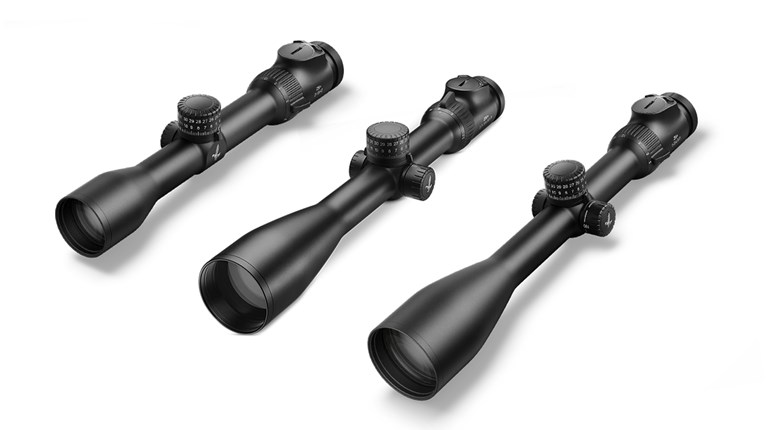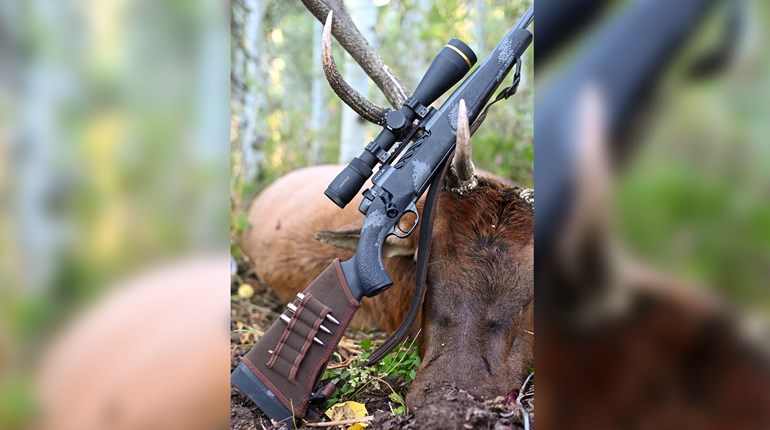
There’s no denying the Aimpoint Comp M4 is a hero in the War on Terror, with more than 700,000 of the rugged little red-dot sights deployed by the U.S. military and another half million units on the way. Utterly dependable and lightning-quick on target, it has become the go-to rifle sight for a new generation of American shooters.
Can this technology also apply to hunting? In fact Aimpoint is banking on just that with its new Hunter series. The Swedish company recently introduced a product line built especially for big-game hunters, a sight styled to fit both traditional and modern sporting rifles, and one that will help bridge the gap for returning vets as they transition to field shooting.
In truth Aimpoint has been in the hunting-sight business since its founding nearly four decades ago. The initial intended user base was Scandinavian moose hunters, who needed rapid target acquisition to engage quarry driven through dense forest. And the sight’s reflex-collimator principle worked darned good in that snap-shooting, short-range environment. Users could simply throw the gun up and lead with the highly visible red dot. With no need to center the dot or “search” for the right eye relief, this sight proved more intuitive than using a scope. On top of that, the Aimpoints proved virtually indestructible in the face of harsh weather and hard use. Soon this sight had caught on across Europe where organized drives for wild boar, red deer and roe deer account for much of the hunting.
That acceptance hasn’t been quite so forthcoming here in the U.S., where we lean on magnification for making longer, deliberate shots in open country. Some American hunters have found Aimpoint products like the Comp 9000 useful, and turkey guns in particular are often equipped with red-dots.
The Hunter series, however, is purposely aimed at deer, elk and wild hog hunters. The first units boast a 34mm tube and come in long- and short-action models, respectively the 34L and 34S. A more compact 30mm is in the works as well.
The spacious tube and its 47mm objective lens provide a tremendously wide “see-through” area, some 250 percent larger than the view area provided by the 9000 series. Because red-dots are used with both eyes open, field of view limitations aren’t the factor they are with telescopic sights, but nonetheless users tend to “see” only the cross-section encompassed by the unit. Thus, the wide see-through comes into play, the practical benefit being faster target acquisition, especially on moving game, than can be achieved with magnified optics.
I was afforded a sneak-peek of preproduction Hunter sights last fall and had the opportunity to test-fire them at paper targets out to 300 yards. The new Aimpoints feature a 2 minute-of-angle dot (compared to a 4moa dot on many red dots) that allowed precision aiming, and from a benchrest I was able to fire 1½-moa groups at all distances. The controls are housed in a silicon-rubber touchpad atop the center turret for easy access and silent operation. There are 12 intensity settings (plus Off) and click-stop adjustments that move the dot one-half inch at 80 yards for each click. (That may seem a bit confusing to those of us used to quarter-minute clicks, but really it translates to just over 1½ inches for four clicks at 100 yards.) Hunter series units operate on one 3-volt lithium battery, the common CR-2032 size, which, according to the manufacturer, will deliver 50,000 hours of continuous use.
Clearly this is an extremely robust unit, and given Aimpoint’s reputation for ruggedness I would expect nothing less from its unibody housing crafted from aircraft-grade aluminum. The finish is non-reflecting matte black, and Aimpoint says the Hunters are fully waterproof.
I can’t predict if American hunters will embrace this thoughtful new design, but after my initial testing I’m convinced it can equal, if not exceed, the capability of a telescopic sight in many hunting venues. It’s a no-brainer for anyone who participates in deer drives and especially those southerners whose sport involves the use of dogs in the traditional manner. That could translate as well to hound hunters pursuing bear, cougar and raccoon, and I think eastern deer, hog and coyote hunters who set up in brushy areas may also be well-served. Even in the Pacific Northwest, where deer, elk and bears are hunted in tangled rainforest, hunters could reap the benefits from near-instantaneous target acquisition. Based on what I’ve seen, hunters who gain proficiency will find the Hunter series perfectly capable out to 250 yards or even farther.
My guess is that initial interest will come from ex-GIs and others accustomed to using Aimpoints on their military-style rifles, and indeed the Hunter series would seem a perfect match with the growing use of ARs for hunting. For those making the jump from using magnified scopes, there’s a definite learning curve to mastering any red-dot. It takes some effort and self-training to keep both eyes open. But in fact it’s completely intuitive—the red dot effectively directs your eye and attention. I’m not kidding when I say if I can do it, you can too.
For now, the Hunter series is exclusively offered via three major internet/mail-order houses: Brownell’s, MidwayUSA and SWFA Outdoors.




































